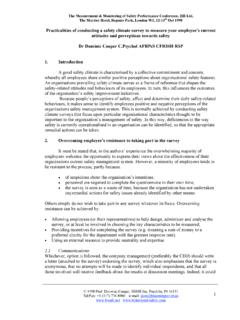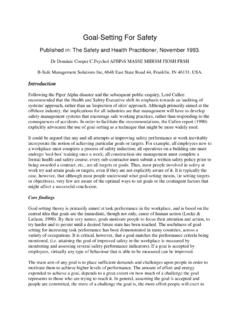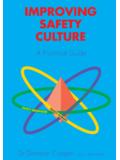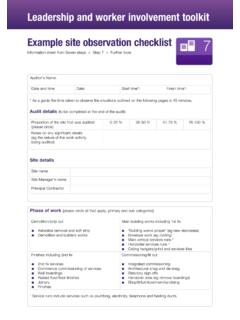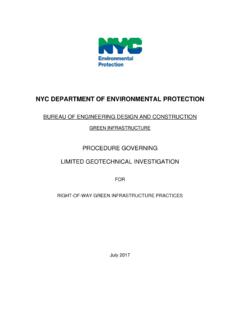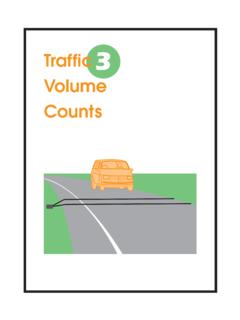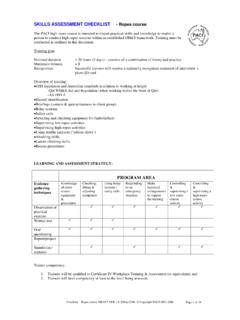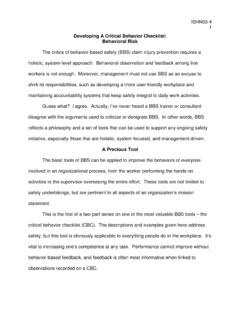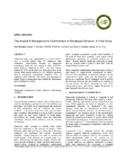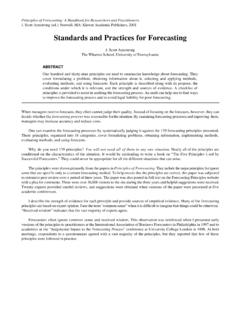Transcription of reducing workplace accidents - Behavior-based safety
1 reducing workplace accidentsBehavioural safety programmes can help toprevent work related accidents and diseases,which are expensive for companies. Researchhas shown that up to 80% of work related accidentsare caused by employees is about identifying bad habits that couldcause accidents or lead to ill health and reinforcinggood habits. It s important not to confuse thisapproach with inspections, which are looking forunsafe conditions. Safe behaviour is regarded as acritical work related skill so unsafe behaviours canact as an early warning system for accidents andincidents. If we measure these behaviours, thisprovides information we can use proactively toimprove workplace safety and do organisations need to do beforeintroducing a behavioural safety programme?If a behavioural safety programme is to be effectiveit must be implemented well.
2 There are severalstages to follow for a successful implementation. Thefirst is to assess whether the company is readyculturally for such a programme. For example isthere management commitment to the idea, doesthe company have a good internal communicationstrategy and is there a fair blame culture? A surveycould be carried out before the programme starts tomeasure the safety is essential to have support from both themanagement and work force. The best way to gainExcellence in workplace safety and health2 Behavioural safety is a key part of a business s journey towards ensuring excellence in workplace safety and health. Here Jill Joyce, Senior Policy & Research Adviser at the Institution of Occupational safety and Health (IOSH) explains the process thatcompanies can FEATURE support from employees is to involve them in theprogramme.
3 A steering group needs to be set up tooversee the programme and it is important that thisis representative of the whole next step is to train the observers how to identifycritical safety behaviours, what to record and how toprovide feedback. It s important that everyone isusing the same criteria to judge behaviours. It isusual to compile a checklist of critical can be based on analysis of previous accidentsor incidents. Near misses are particularly importantto consider as they may give an indication ofbehaviours that could have led to accidents . Whenthe checklist is ready, it is useful to establish a baseline by conducting initial observations and noting thecurrent level of safe behaviours. This enables futureprogress on the programme to be measured. 3, 4 Then there follows a continuous loop of observation,feedback and review and if necessary training.
4 It simportant that feedback is phrased positively so thatsafe behaviours are reinforced. For example,someone who is acting safely would be praised, butsomeone who was not would be told how they couldchange their behaviour without apportioning blameto them. The data from the observation process canbe used to examine trends and identify areas forimprovement. Participative goals that employeeshelp to set are more can be givenfor meeting safe working goals, for example at theLondon Olympic Park, these ranged from verbalpraise to monetary rewards, vouchers, knock offearly schemes, T shirts and fleeces leadership is importantManagers need to show commitment to the processand can do so by allowing observers time to conducttheir observations and encouraging employees toreport problems with safety and health.
5 They shouldpraise individuals they see working safely and ensurethere are resources available if any corrective actionsare s also important to understand why employeesmight behave unsafely. For example, do workdeadlines mean that they have to cut corners (forexample not using a mask because it isuncomfortable and a job will not take long to do)? Do employees understand the risks associated witha particular task or are there ergonomic factorsthat prevent them behaving safely? At the LondonOlympic Park construction site, employees handedout yellow and red cards to highlight unsafebehaviour. These were followed up with a discussionwith the employees concerned to establish why theyacted unsafely. Behaviour based approaches work best when thephysical environment and plant are well maintainedand procedures are in place.
6 The benefits ofintroducing a behavioural safety programme withinan organisation is the opportunity it provides for thewhole workforce to co-operate together proactivelyto continuously improve safety and T (1991) safety culture and risk management inorganisations. Journal of Cross Cultural Psychology. Volume22 pp 129-1402 (2009) Behavioural safety Interventions Areview of process design factors. Professional safety February2009, for higher standards behavioural safety IOSHW igston. 2013 , Latham (2002) Building a practically usefultheory of goal setting and task motivation: A 3 year Psychologist 57 (9) 705-7176 Sudden C et al (2012) safety culture on the Olympic JoyceSenior Policy & Research AdviserInstitution of Occupational safety & Health (IOSH) FEATUREby unwanted behaviours, or those triggered by aninteraction between poor controls, hazards, andbehaviours.
7 Defined as an unexpected and unwanted event , anincident refers to property damage, a quality problem,a personal injury, or a catastrophe. Incident pyramids (shown opposite), illustrate thatmost incidents have a relatively mild impact, andthat critical impacts ( catastrophic) are relativelyinfrequent events. It is a matter of chance, however,whether a mild impact event may have been moreserious, as the severity of the outcome cannot becontrolled in the same way as the inputs. Preventative opportunities arise, therefore, fromcontrolling unwanted behaviours, eliminating hazards,and tightening management controls at the base ofthe pyramid. Behavioural safety helps to identify theissues in all of these areas. Simultaneously focusingon all of these, significantly reduces the possibilityof a critical impact event, while greatly improvingperformance and efficiencies.
8 People s behavioural choices account for around 56%of all potential serious injuries and fatalities (SIFs),with poor management controls ( job planning),and physical hazards accounting for the remainder. Dominic Cooper, PhD CFIOSH CPsycholIntroduction to Behavioural SafetyWhat is a 12% productivity increase worthto your company, in addition to 30%reductions in insurance premiums, around30-70% reductions in undesired incidents,and significantly reduced operating costsfor your company? Behavioural SafetyThese proven, real world results have been achievedwith behavioural safety approaches over the pastfive decades in a wide variety of industrial andcommercial in the USA in the mid-1970 s, behaviouralsafety came to Europe in the late 1980 s, early 1990 swhen the British Health and safety Executive (HSE)funded two construction research projects at UMIST with a team including Professor Dominic Cooper ofBSMS, Dr Tim Marsh, Robin Phillips and others: the firstsought to establish how to optimise behavioural safetyfor the European Culture, while the second focused onindustry applications.
9 Successfully improving safetybehaviour, both projects also demonstrated theimportance of people s commitment to the process. Equally applicable to both quality and productivity,the purpose of behavioural safety is to reduce thenumber of unwanted incidents caused either bypoor management controls, and/or hazards presentin the working environment: those triggered solely4 Over each of the past 30 years, UK incident datareveals a stable experience average of 20,000 actualSIF s, while less serious reportable injuries droppedfrom 180,000 to 60,000 per year. This shows thatexisting risk control strategies are not reducing veryserious injuries at the same rate as less severeinjuries, and that something new is required and/orexisting strategies need tightening. 87% of all potentialSIF s can be observed duringsafety leadership walk-rounds and behaviouralsafety observation tours.
10 Subsequently recorded inPEER software, the build-up of potential SIF s ismonitored so that any underlying contributorscanquickly be identified and addressed. Recognising that safety is a social activity, where oneperson s behaviour can affect many, behaviouralsafety approaches systematically address behaviouralchoices, management controls and physical hazardsin a proactive and planned manner. Targeting people sbehaviour at all organisational levels to addressthese, helps to create a safety partnership betweenmanagement and employees. 5 Behavioural safety LeadershipSafety leadership can positively impact people ssafety behaviour by up to 86%, and reduce incidentsby around 35%. Leaders who set their people up forsuccess, facilitate their follower s needs, and showthey care, are very successful at positively impactingperformance.
